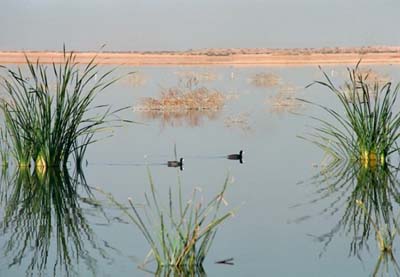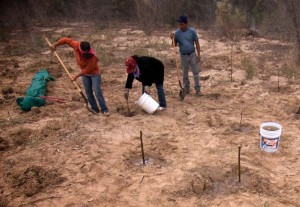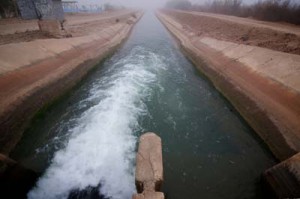In this installment of our series on the Lower Colorado River, conservation and restoration efforts on the Mexican side of the International Border will be explored. Stay tuned for the final installment, which will examine cooperation between American and Mexican entities. The Colorado River conservation community is tight-knit, but there are transnational political considerations to be made when working with a natural resource that isn’t confined by political boundaries.
Part I: SOMETHING FOR EVERYONE
Part II: JUST ADD WATER: COLORADO DELTA RESURRECTS
Part III: THE RISKY BUSINESS OF SLICING THE PIE
Driving across the western edge of the dusty, barren Sonoran Desert south of the border between the United States and Mexico, it’s easy to get the feeling that if it weren’t for the regular occurrence of irrigation ditches, there wouldn’t be any water there at all.
The fields are green, but everything, from crop leaves to cars to houses, is covered with a fine, dry dust. From Yuma, Ariz., through San Luis Rio Colorado, Sonora and through the busy agricultural area on the way to the Gulf of California — also known as the Sea of Cortez — farms become less frequent and the terrain more featureless.
After a particularly jarring few miles on unpaved washboard roads, a little hamlet called Ejido Luis Encinas Johnson appears, the desert beyond the palm tree-bedecked oasis unfolding into a vast tan sheet. It takes another 20 minutes or so to drive across the shifting desert sand on a vaguely defined track until the Ciénega de Santa Clara wetland — 12,000 acres of reed-choked marsh that today makes up the terminus of the Colorado River Corridor — appears on the horizon.
Before the 20th century, when the great Colorado River dams were built, the river took a course similar to my driving route as it meandered across the gradually flattening alluvial plain stretching from Southern Nevada to the Gulf. Yuma was a port city and large steam ships regularly traveled to and from San Francisco, transferring freight onto barges at Yuma to ship further up river.
Today, several dams along its course — two, the Hoover and Glen Canyon dams, are among the more colossal structures ever conceived by human engineering — along with reservoirs, levees and diversion canals, have bent the river to the will of human activity.
Just before it reaches Yuma, the Colorado is diverted east and west to the great farms of California’s Imperial Valley and to Southern Arizona. Once wild and unpredictable, prone to violent, muddy floods, what is left of the Colorado now obediently gurgles toward the border crossing in a small channel, where it is again diverted by Morelos Dam in order to provide Mexican farms and communities the annual 1.5 million acre-feet they are guaranteed by treaty to receive. From there, it abandons any semblance of its original course, tracking west into Mexico’s irrigation system toward the populous Mexicali Valley, which currently has almost 500,000 acres of irrigated farmland in production. With no direct connection to the river, the Delta is fed instead by agricultural return flows and very occasional rainfall.

When the Hoover Dam — almost 250 miles upstream from the Delta — was completed in 1936, it took several years for Lake Mead to fill.
During that time, scarcely any water reached the Delta, and it began to dry up. From 1963 until 1981, as Lake Powell filled behind Glen Canyon Dam, the Delta experienced a much longer dry spell, this time all but disappearing. Native plants withered and died on the desiccated land, and many insects, fish, birds and mammals — including such formerly prolific species as the desert pupfish, the Yuma clapper rail, the vaquita porpoise and the Colorado delta clam — began to disappear, too.
The drastic changes forever altered life for the Kwapa (or Cocopah) Indians, a semi-nomadic tribe whose people had hunted, fished and lived their lives around the ebb and flow of the alluvial plain for thousands of years.
Just when conservationists were ready to tick off the Delta as a lost cause, the winter of 1983-84 brought one of the wettest El Niño seasons on record. The millions of acre-feet of water storage capacity on the Colorado River system was quickly used up, and the U.S. Bureau of reclamation was forced to release some of it to prevent flooding.
“By the early 1980s, the Delta was a forgotten ecosystem, but it’s very resilient. You add a little water and it comes back to life,” said Francisco Zamora Arroyo, a biologist from the Sonoran Institute. Since 1998, the institute has been working on habitat conservation and restoration projects along the Colorado River corridor in Mexico.

Where native cottonwood, willow and mesquite trees had withered away and been replaced by nonnative salt cedar, conservationists were surprised to see the natives coming back. It was that season, Arroyo said, that spurred them into action, leading to the extensive programs in place today.
“I think we have set realistic goals in terms of restoration and securing water,” he said, pointing out that with the demands currently being placed upon the river’s water supply, habitat in the Delta will never be what it once was. With their sights set on enhancing around 80,000 acres of habitat along the Colorado River corridor, everything is dependent upon the amount of water rights they are able to procure. So far, less than a thousand acres have been restored, but Arroyo said that work is progressing steadily.
After a fairly wet decade, enough attention was focused on the Delta to prompt the Mexican government to petition the United Nations Education, Scientific and Cultural Organization to list it as a Biosphere Reserve, a designation it received in 1993.
Unlike its superpower neighbor to the north, Mexico has limited funding available for environmental projects, so the work has fallen largely to nongovernmental organizations on both sides of the border. Two, Tucson-based Sonoran Institute and Mexico City-based Pronatura, partnered in 2002 to adopt a community-oriented approach to restoration projects. A number of other U.S. and Mexican nongovernmental organizations also are involved, as well as research groups from the University of Arizona and Universidad Autonoma de Baja California. By 2005, they had formed the Colorado River Delta Water Trust (see PowerPoint presentation here) in order to buy water rights for habitat restoration projects.
“We have been securing water rights in the Mexicali Valley, and our goal is to get at least 50,000 acre-feet,” said Arroyo, adding that the 15 restoration projects they have in operation along the Colorado’s irrigation-dictated route all use water fed from the irrigation system. “This is the first year [of operation], and we already have 1,450 acre-feet.” The goal is to have enough water to be able to flood and dry out restoration plots to mimic the pulse flows seen in the area when the Colorado River was undammed, although he said that most of the water they get now is inadvertent return flows and seepage.
While the main focus of the Sonoran Institute and Pronatura’s efforts are on the Ciénega, Arroyo noted that restoring habitat along the banks of the river helps the Delta as well. “Salt cedar is better than nothing, but the birds prefer the diversity of [native] Delta plants,” said Ricardo Olachea, a Pronatura marine biologist. He added that because the Delta is along a main path taken by migratory waterfowl, providing good habitat is important. Conservation scientists tend to address the river corridor as a whole rather than as isolated test sites, said Arroyo, and particularly in a setup like this, where the upstream riverbanks act as a filter for water going into the Delta.
Lacking the funding and mechanization enjoyed by their Bureau of Reclamation counterparts north of the border — with an average annual budget of about $400,000 in comparison with the hundreds of millions the bureau has at its disposal — Arroyo and other project managers in Mexico are employing manual labor from nearby communities.
Although machines finish the work much more quickly, Arroyo said that their method is getting locals engaged in the process.

On a warm winter day this past December, about 20 miles south of Mexicali, Aurelio Alfaro Rodriguez, 32, a former farm worker, toiled in the bright sun, clearing a site of nonnative salt cedar with a machete. Assisted by perhaps half a dozen other people, he was making way for plantings of native cottonwood and mesquite trees along one of the many irrigation-fed oxbows — called son in Mexican Spanish — that the institute is using as platforms for restoration.
“I’ve learned a lot of things since I started working here. I understand it all better now,” he said, wiping the sweat from his brow with a dusty hand. Arroyo said he has met people who didn’t even know the Colorado River crossed through their communities.
Fostering eco-tourism has also been a major goal of the Sonoran Institute’s program, both to generate public interest and funding for restoration efforts and to educate locals and visitors about the area’s natural ecology. They have set up eco-camps at the Ciénega — whose marshes are a haven for duck hunters and fishermen — and at several of the riverbank restoration sites.
“Economically, the local people can work in eco-tourism and bird-watching. It will make a healthier area with more birds, trees and fish,” Arroyo said. Environmental groups have also gotten involved in turning the Las Arenitas primary wastewater treatment plant pond — located about 45 minutes’ drive from Mexicali — into a giant wetland. The reeds along its banks filter leftover contaminants before the water is returned to the Colorado River.
The site is attracting scores of waterfowl, luring in birdwatchers from all over the region and even grabbing the attention of the state government, which has promised Arroyo’s team funding for a visitor center and a parking area.
Considering their somewhat limited funding, the coalition of NGOs and academic researchers engaged in habitat conservation and restoration projects on the Mexican side of the border has been largely successful in their efforts.
While survival of trees planted along Rio Hardy — a salty tributary fed by agricultural runoff — have been a little lower, in the Delta and along the main stem of what now makes up the Colorado River, it has been as high as 80 percent. As native cottonwood, willow and mesquite trees begin to flourish, the species that use them as habitat gradually return.
Along with restoring a connection between the Ciénega and the Gulf of California — there is still a sizable stretch of dry, salt-crusted wasteland between the desert oasis and the Gulf — there are a number of hurdles to overcome. Water allocations from north of the border are a complex and ever-changing property, but Arroyo and his colleagues are confident that if they keep chipping away at it, something that works for both man and nature can be created.
Sign up for our free e-newsletter.
Are you on Facebook? Become our fan.
Follow us on Twitter.




